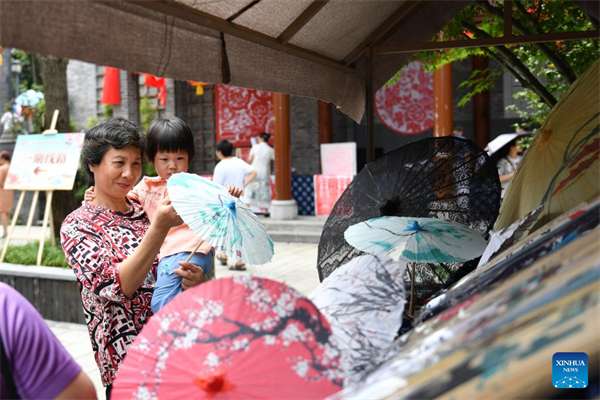This photo taken on Sept. 16, 2023 shows visitors shop at the intangible cultural heritage exhibition held in Scroll Town in Suxian District of Chenzhou City, central China's Hunan Province. (Xinhua/Chen Zhenhai) CHANGSHA, Sept. 19 (Xinhua) -- Jiang Qiugui, 62, was left in awe after walking on the mossy stone roads and appreciating the delicate architecture at a scenic spot in Suxian District of Chenzhou City, central China's Hunan Province. The Changjuan culture and tourism town, or "Scroll Town," is a place with replicas of iconic antique buildings from 11 districts and counties of Chenzhou. It also gathers the intangible cultural heritage features of many sites nationwide. In mid-September, an intangible cultural heritage exhibition was held in the town. As a representative inheritor of the intangible cultural heritage of the Linglong tea-making technique in Hunan Province, Jiang and a 10-year-old apprentice showed their tea-making skills to the visitors during the exhibition. However, not long ago, the town's land was heavily polluted and lay in waste. "In the past, Chenzhou was famous for its minerals. In the 1980s and 1990s, the Yangxi River basin, where Scroll Town is located, bustled with mining activity," said Zhu Qianjin, commander of the coordination headquarters of the Scroll Town project. In those years, some enterprises had poor environmental protection awareness, causing pollution in rivers and soil, Zhu added. To turn "environmental debt" into development wealth, the Suxian District started to promote the control of heavy metal pollution and ecological restoration in the Yangxi River basin. Today, the traces of mining and mineral processing have been replaced by lakes, grasslands, and historical and cultural blocks. After treatment, the once-polluted area has become a popular tourist attraction. "By paying off the 'environmental debt' through ecological restoration, we can achieve multiple goals by showing intangible cultural heritage and presenting a new image," said Jiang. As a city rich in mineral resources, the mining economy once accounted for 60 percent of Chenzhou's GDP. Chenzhou hopes to show the modernization picture of harmony between humanity and nature through the transformation of development concept, governance mode, industrial development, and ecological value, said Wu Jupei, secretary of the Chenzhou municipal committee of the Communist Party of China. Thanks to the change in development concept, more residents in Chenzhou also benefit from the city's ecological restoration efforts. In Kuandong Village, Beihu District of Chenzhou, villagers who worked away from home returned to their hometown. They started homestay businesses as the number of tourists increased. At present, there are about 30 homestays in the village. "The change is closely related to ecological restoration," said He Guojun, an official with the Kuandong Village. This photo taken on Aug. 24, 2023 shows a homestay in Kuandong Village, Beihu District of Chenzhou City in central China's Hunan Province. (Xinhua/Chen Zhenhai)

Central Chinese City Revived After Embracing Green Development
Editor:谭婕倪
Source:Xinhua
Updated:2023-09-25 09:52:12
Source:Xinhua
Updated:2023-09-25 09:52:12
Special
Contact
Welcome to English Channel! Any suggestion, welcome.Tel:0731-82965627
lisl@rednet.cn
zhouqian@rednet.cn











